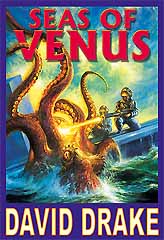
For my thirteenth birthday, my parents gave me a collection of SF (bought from a guy who was entering the Navy) which included The Astounding Science Fiction Anthology. Among many other great stories in the volume—it was John Campbell's own distillation of Golden Age SF, after all—was Clash by Night by Lawrence O'Donnell.
It was years before I learned that Lawrence O'Donnell was a pseudonym of C.L. Moore and her husband Henry Kuttner. Most O'Donnell stories were written primarily by Moore, but this one seems to have been Kuttner's work in large measure. (After Kuttner's death, Moore renewed the copyright in Kuttner's name alone.)
Details of authorship didn't matter to me when I was thirteen, and they don't matter a great deal now: Clash by Night really blew me away. A writer is what he reads, and this story marked me to a greater degree than I could've imagined at the time. (Well, at the time I couldn't have imagined that I was going to be a professional writer. Even after twenty-odd years it seems pretty strange.)
Kuttner and Moore wrote about mercenary soldiers of the future, basing the concept on the Condottieri of Renaissance Italy. These bands were more romantic than most mercenaries (in part because they didn't do a lot of hard fighting), and many writers, Kuttner and Moore included, have emphasized the romantic aspect.
But the Condottieri were also businessmen—the name means contractor and is the same word you'd use if you were hiring someone to build your house or to carry your goods from Venice to Rome. In recognizing the business aspect of mercenary soldiering, Clash by Night from 1943 is an order of magnitude ahead of most stories about mercenaries written either before or after it.
I jumped at the opportunity to get Clash by Night reprinted when Marty Greenberg suggested I do a sequel to it for a series of double novels he was packaging. I wrote Surface Action as a thematic sequel which could've been published in Astounding in 1943. In Kuttner and Moore's story, a young soldier who thinks he wants to be a civilian comes to a realization about himself and his world. In mine, a young civilian who thinks he wants to be a soldier reaches a similar insight.
Surface Action didn't appear in the double series (the details are on my website for those who want them) and was instead published separately. Because it didn't appear with Clash by Night I made minor changes to the terminology, but it remains a direct response—and homage—to the original. I then wrote The Jungle in order to get Clash by Night back in print.
Surface Action has a simple plot and a structure that would have fit in with the fiction Astounding was publishing in the 1939-43 period (which I and many others consider the Golden Age of Science Fiction). I don't like to repeat myself, so for The Jungle, I went to multiple viewpoints and paired each segment of consecutive narrative with a flashback from the same viewpoint but set at widely varying periods of the past. The structure is more complex even than what I used on the much longer Northworld Trilogy. I'm happy with the way the experiment worked out, but I've never tried to do anything like it again.
Writing a story always has an element of puzzle in it. These two novels had more than the usual, because I was writing in someone else's universe and using assumptions current in 1940. I doubt that Kuttner and Moore really believed in an ocean-covered Venus, but they could set their story on one without explanation (and indeed, Isaac Asimov could do the same in 1955). Before I could get on with my story, I needed to throw in terraforming and evolutionary developments which are more colorful than probable.
My story is about people; about the way people feel and think and interact under stress. That's the same subject that Kuttner and Moore addressed, and it's the focus of most of the fiction that interests me.
The novels gave me scope for writing about the natural world—which in their case was mostly my backyard writ large. I've never subscribed to the suburban dream of neatly manicured lawns. Our present house is in the middle of a 15-acre meadow which we bushhog once or twice a year to keep trees from taking over. At the time I wrote Surface Action and The Jungle we were on a half-acre lot, but we'd deliberately allowed the back—where I wrote outdoors, using laptop computers—to go feral if not exactly wild. This setting added immediacy to the descriptions of hostile blackberries and honeysuckle. Once I had to wait before copying because a jumping spider had crawled into the floppy drive and I didn't want a tragic accident.
As a whim—mine and Jim Baen's both—this volume also includes an account of my family vacation in the rain forest of Belize. It's not my first experience of real jungles—that came in War Zone C in 1970—but it's by far the more pleasant. Those of you who aren't interested in non-fiction can ignore the travelogue, but those who read it will be able to recognize echoes in future fiction of mine that touches in any way on jungles or lost cities. Based on my stories to date, that'll be a pretty high percentage of my output.
My main consideration in writing both Surface Action and The Jungle was to get more people to read Clash by Night. If you like what you read here, look for the original; I've reprinted it a couple times myself, and I believe there's an on-line version available for a modest charge.
Having said that, these novels gave me great pleasure to write. I hope that some of the fun I had will translate to pleasure for the readers.
Dave Drake
david-drake.com